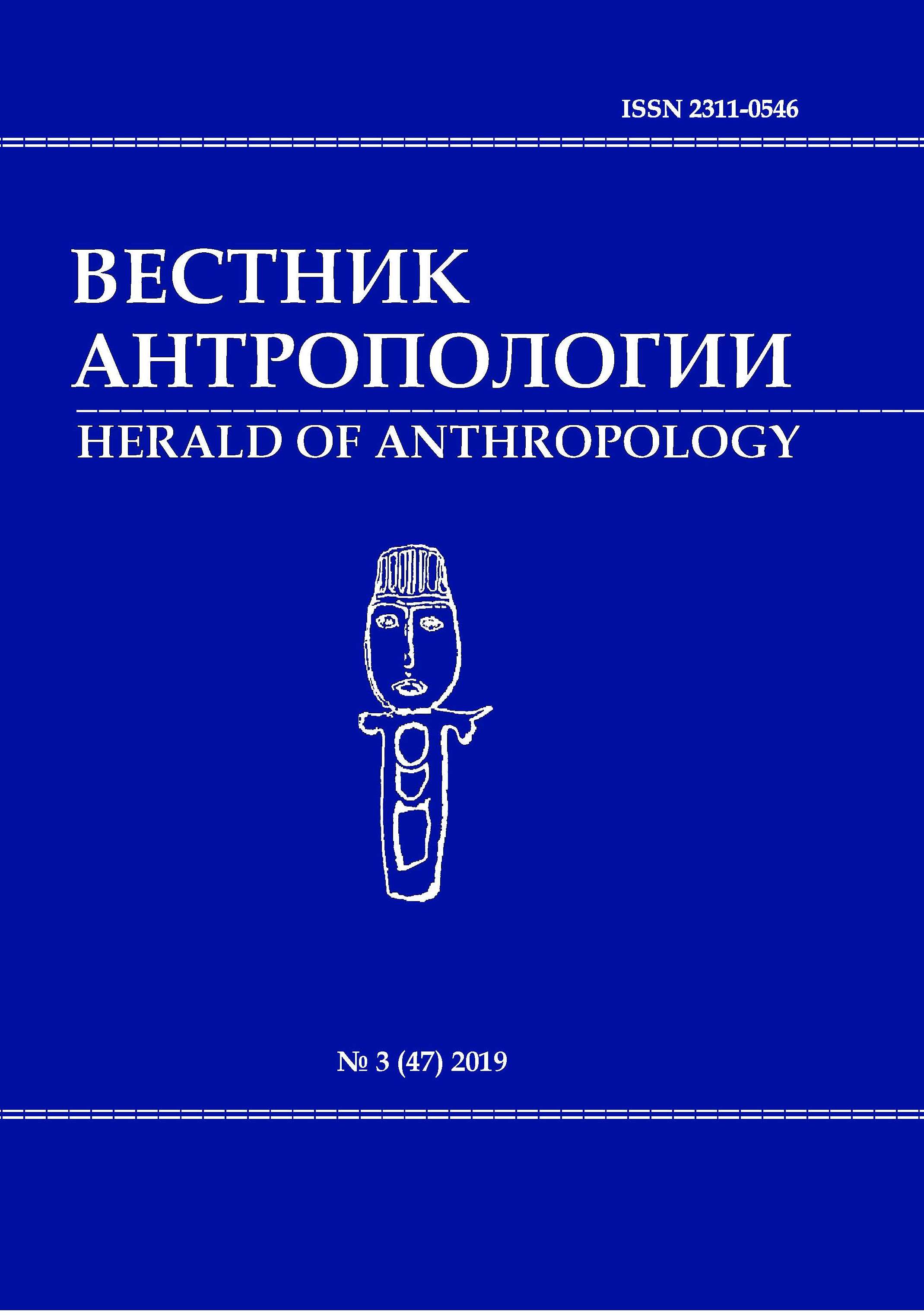Russian Ballroom Culture: Europeanization and original traditions (sociocultural essay)
DOI: 10.33876/2311-0546/2019-47-3/144-154
Keywords:
ball, ballroom dancing, Europeanization, fashion, costume history, nobilityAbstract
Dance is definitely a cultural phenomenon. The well-known Russian historian Yuri Lotman outlined the concept of «culture» as a form of social communication between a group of people. Pair dancing is the best way to illustrate this statement. Dancing itself is the language of communication for a particular society. To be a full participant in such social intercourse, you must have the knowledge of the «language» of the group, follow the protocol of behavior and demonstrate membership / loyalty to the group. Dance is a non-verbal form of communication, built on the interaction of dancers in specific movements and symbolism of appearance and attributes. Ballroom dancing is a symbol of belonging to the nobility, participation in balls is a confirmation of loyalty to the ruling elite, the state.
References
- Ageeva, O (2006). Evropeizatsiia russkogo dvora 1700–1796 gg. [Europeanization of the Russian court of 1700-1796]. Moscow: Institut rossiiskoi istorii RAN.
- Andreeva, A (2009). Kostium russkoi znati. Ot Vizantii do moderna [Costume of the Russian nobility. From Byzantium to Art Nouveau]. SPb: Paritet.
- Dmitrieva, M (2009). Materialy pervoi konferentsii po voprosam rekonstruktsii evropeiskikh istoricheskikh tantsev XIII – XX vv. [Materials of the first conference on the reconstruction of European historical dances of the XIII – XX centuries]. In V Bal’nyi etiket XIX veka v Rossii [The Ball etiquette of the XIX century in Russia]. Spb.: Kul’tInformPress.
- Druzhininskaya, O.V., and I.N. Kataeva. 2008. Bal kak kul’turnoe iavlenie XIX veka: iz istorii slov [Ball as a cultural phenomenon of the XIX century: from the history of words]. Vologda: Voronezh State Pedagogical University.
- Dukov, E. 2000. Bal v kul’ture Rossii XVIII – pervoi poloviny XIX veka [Ball in the culture of Russia XVIII – the first half of the XIX century]. In Razvlekatel’naia kul’tura Rossii XVIII – XIX vv [The Entertaining Culture of Russia XVIII – XIX centuries], edited by E.V. Dukov, 173–195. St. Petersburg: Dmitrii Bulanin.
- Entelis, N. 2014. Pushkinskii bal s opisaniem traditsii i podlinnymi tantsami [Pushkin Ball with a description of traditions and genuine dances]. Petersburg: Composer.
- Eremin-Solennikova, E. 2010. Starinnye bal’nye tantsy. Novoe vremia [Ancient ballroom dancing. New time]. St. Petersburg: Lan’.
- Kolesnikova, A. 2005. Bal v Rossii: XIII – nachalo XX veka [Ball in Russia: XIII – beginning of XX century]. St. Petersburg: Azbuka-klassika.
- Kotovskaya, M. 2012. Istoriia mody i povsednevnosti po materialam zhurnalov serediny XVIII – nach. XX vv.[The history of fashion and everyday life according to the materials of magazines of the middle of the XVIII – beginning. XX centuries]. Mosocw: RIO MGUDT.
- Lotman, Yu. 2015. Besedy o russkoi kul’ture: Byt i traditsii russkogo dvorianstva XVIII – nachalo XIX veka [Conversations about Russian culture: Life and traditions of the Russian nobility (XVIII – beginning of XIX century)]. St. Petersburg: Azbuka, Azbuka-Attikus.
- Mikhnevich, V. 2007. Russkaia zhenshchina XVIII stoletiia. [Russian woman of the XVIII century]. Moscow: Kuchkovo field; Hyperborea.
- Mikhnevich, V. 2015. Dancing in Russia in a round dance, ball and ballet historical essay [Pliaski na Rusi v khorovode, na balu i v balete istoricheskii ocherk]. Moscow: X-History.
- Nesmeyanova, I. 2007. Rossiiskii imperatorskii dvor pervoi poloviny XIX veka kak sotsiokul’turnyi fenomen [The Russian imperial court of the first half of the 19th century as a sociocultural phenomenon]. Chelyabinsk: Recpol.
- Ogarkova, N. 2004. Tseremonii, prazdevstva, muzyka russkogo dvora XVIII – nachala XIX veka. [Ceremonies, celebrations, music of the Russian court of the XVIII – beginning of the XIX century]. St. Petersburg: «Dmitry Bulanin».
- Pervushina, E. 2013. Peterburgskie zhenshchiny XIX veka [Petersburg women of the XIX century]. Moscow: Tsentrpoligraf.
- Ruan, K. 2011. Novoe plat’e imperii: istoriia rossiiskoi modnoi industrii, 1700 – 1917 [A new dress of the empire: the history of the Russian fashion industry, 1700–1917]. Moscow: Novoe literaturnoe obozrenie.
- Rudenko, T. 2015. Modnye magaziny i modistki Moskvy pervoi poloviny XIX stoletiia [Fashion shops and milliners of Moscow in the first half of the 19th century]. Moscow: Tsentrpoligraf.
- Russkii arkhiv. Istoriia Otechestva v svidetel’stvakh i dokumentakh XVIII-XX vv 2001. Pis’mo V.N. Repninoi k V.A. Repninoi-Volkonskoi; Peterburg, 23 dekabria 1831 g. [Russian archive. History of the Fatherland in certificates and documents of the 18th-20th centuries 2001. Letter by V.N. Repnina to V.A. Repnina-Volkonskaya; Petersburg, December 23, 1831]. Moscow: Editorial office of the almanac «Russian Archive».
- Ryzhkova, N. 2000. Bal’nye tantsy i russkaia muzyka [Ballroom dancing and Russian music]. In Maska i maskarad v russkoi kul’ture XVIII – XX vekov [The Mask and Masquerade in Russian Culture of the 18th-20th Centuries], edited by E. I. Strutinskaya, 49–62. Moscow: Gosudarstvennyi institut iskusstvoznaniia.
- Stil, V. 2010. Korset [Corset], translated by M. Malikovoi. Moscow: Novoe literaturnoeobozrenie.
- Vasiliev A.A (2015). Etiudy o mode i stile [Fashion and Style Studies]. Moscow: Al’pina non-fikshn; Glagol.
- Zakharova, O (2011). Russkii bal XVIII – nachala XX veka. Tantsy, kostiumy, simvolika [Russian ball of the 18th – early 20th centuries. Dances, costumes, symbols]. Moscow: Centerpolygraph.
- Zakharova, O. 2012. Baly Rossii vtoroi poloviny XIX – nachala XX veka [Balls of Russia in the second half of the XIX – early XX centuries]. St. Petersburg: Lan’, Planeta Muzyki.
- Zakharzhevskaya, R. 2009. Istoriia kostiuma [The history of the costume]. Moscow: RIPOL classik.
- Zimin, I. 2011. Vzroslyi mir imperatorskikh rezidentsii. Vtoraia chetvert’ XIX – nachalo XX v. Povsednevnaia zhizn’ Rossiiskogo imperatorskogo dvora [The adult world of imperial residences. The second quarter of the XIX – the beginning of the XX century. Everyday life of the Russian imperial court]. Moscow: Tsentrpoligraf.





















